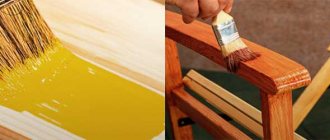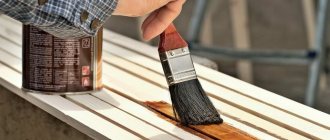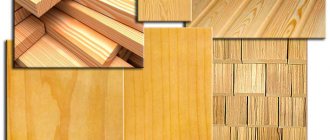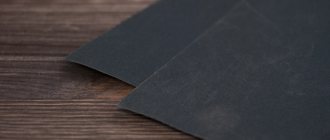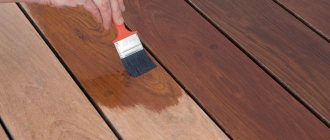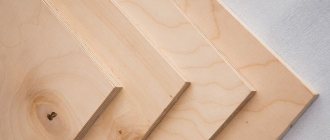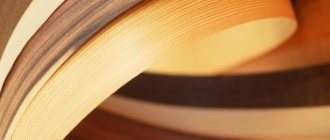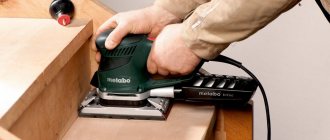Wood products, finishing from various types of wood, wood as a building material are always popular. Wood is a beautiful, warm, stylish, easy-to-process material. When making various panels, parts, fragments and compositions, along with fasteners, wood glue is required. Which of its several varieties is better to choose, what features and properties each of them has - let's figure it out.
Every day new varieties of wood glue appear, and well-tested ones are constantly being improved and their characteristics are improving. The choice of such adhesive depends on the characteristics of the product or structure made of wood, and the required properties after manufacture.
Children's crafts, paper applications and various three-dimensional paper toys are strongly associated with this name. But polyvinyl acetate glue (PVA) has proven itself to be excellent when applied to wood. Many carpenters and woodworkers love to work with it. The disadvantage of PVA is its instability to moisture. Therefore, it is not suitable for outdoor use and damp areas. However, it is convenient to work with, it is inexpensive, and dries quickly.
Recently, moisture- and even water-resistant PVA has appeared. They are more resistant to moisture, but much more expensive than regular glue. Another advantage of PVA is its lack of toxicity.
Wood glue
Wood glue - classic. It has features related to manufacturing. The quality of the glue depends on this process. The powder for its preparation can be bone or flesh. Use hot wood glue; as it cools, it thickens and hardens. You can soften it in a water bath or steam. Suitable for restoration of antiques and repair of ancient musical instruments. The sound of an instrument sometimes depends on the quality of wood glue.
The modern version of wood glue does not harden during the cooling process, making it much more convenient to work with. Sold in liquid form, no mixing or heating is required. Apply a thin layer along the grain. Before setting, it is necessary to secure the parts with clamps.
Finger-joined oak furniture panel
Finger-joined oak panels, as well as a number of other types of building materials, are manufactured in production. In the process of manufacturing laminated panels, the method of deep wood processing is used. The massif, prepared in advance and dried to 10-12% humidity, is dissolved into boards and bars, and then glued into a board of a predetermined thickness and length/width dimensions. Wooden finger-joint products are characterized by:
- mechanical strength;
- environmental cleanliness;
- similarity in surface texture to solid oak;
- low cost when making custom-made shields.
Solid lamella oak, which is made from solid lamellas of the same length, glued together along the width, looks even better.
Syndeticone glue
To increase strength, sugar (powdered sugar) and slaked lime are added to wood glue. The result is syndeticone glue. The advantages of this composition are high bond strength, resistance to moisture and chemicals. The disadvantage is the cooking time. The glue must swell for 12 hours before use.
Full-lamella gluing
An option in which furniture panels or steps are glued together from lamellas of wood of the same type, equal in size. In this case, gluing occurs only along the width. The length of the board remains solid. This allows you to maintain a beautiful, uniform wood grain pattern throughout its entire length. Which makes the product more attractive, looking like a solid piece of wood.
For gluing, a special waterproof, high-strength adhesive (with an environmentally friendly composition) is used.
Casein glue
If desired, casein glue on an organic basis can be made even at home, because casein is part of cow's milk. But ready-made powder for preparing an adhesive is available on sale. Before use, it must be diluted in cold water, stirring thoroughly. Preparation takes 60 minutes. Casein glue is used for gluing wood and leather, wood and fabric. Glue has been used for a very long time, and it is still quite popular today.
Epoxy resin
Epoxy resin adhesive is a two-component adhesive, one of which is a hardener, the second is a resin. It is increasingly used in furniture production. It is valued due to the strength of bonding of parts, moisture resistance, and resistance to various chemical influences. It is difficult to calculate exactly the required amount of glue. If there is more quantity than required for gluing, the remainder will have to be thrown away.
Important! Epoxy glue should be used carefully by people with allergic reactions and work exclusively with rubber gloves. In case of contact with skin, irritation may occur.
Where can I buy?
The website of the Trade House "Massive" presents a wide variety of lumber for making furniture and stairs. Including decent quality and affordable furniture panels, stair steps and turntables, in the manufacture of which solid-lamella or spliced gluing was used.
Our advantages:
- Huge range of quality materials
- Favorable delivery
- Great prices, including wholesale
They cooperate with us and trust us!
Call or leave requests on the website. We will contact you shortly.
Polyurethane glue
One of the most expensive types of wood glue, but it has excellent characteristics. Resistant to moisture and temperature. It is applied to a damp surface. You only need to work with it while wearing gloves to avoid dark fingerprints on the surface to be glued. Glues hard wood well.
If quick gluing of surfaces is necessary, use polyurethane hot melt adhesive using a special gun. Due to its quick setting, it is applicable to small parts or where it is not possible to use a clamp.
Which wood glue to choose?
The answer to the question in the title is that the glue must be chosen depending on the required properties of the product. That is, if you need resistance to high temperatures, then heat-resistant; if you need to glue quickly, then Moment or PVA will be useful; if the wooden structure will be exposed to moisture and water, use casein, polyurethane or epoxy glue.
There are types of glue that are resistant to chemicals, oils, and surfactants. There is wood glue that is waterproof, frost-resistant, resistant to fuels and lubricants, or, conversely, for temporary gluing - its layer can be easily destroyed with a hammer, the parts can be separated using steam, water or heat. An important characteristic of wood glue is how fast it dries.
Which glue is best for wood is not a completely correct question. The modern market offers a range of high-quality products for gluing wooden surfaces. It is best to choose one whose characteristics meet all the consumer’s requirements. It is also useful to listen to the opinions of professionals, reviews of experienced craftsmen and wood specialists.
Methods for connecting beams
There are several ways to glue wooden beams:
- On a smooth reveal: using an adhesive without additional intervention in the wood structure. That is: for an even cut;
- On a microspike: a jagged relief is cut out on the surface of the timber with a milling cutter for better grip;
- On a serrated tenon: the surface to be glued is cut deeply (up to 1 cm) in the form of teeth, which are subsequently inserted into each other.
The most common, affordable and practical is the classic gluing onto a smooth fugue using a special adhesive.
How to glue wood to wood
What glue to use to glue wooden parts to each other depends on several factors:
- wood species, wood colors;
- where the glued structure will be permanently located;
- what impact will be exposed to;
- size of parts and surfaces to be glued;
- what load the adhesive joint must withstand.
Also important are the cost of the glue, its consumption, whether it needs to be prepared and for how long, the speed of drying and hardening. Knowing all these parameters, an experienced craftsman can easily determine which glue is best suited for this product, parts or structure.
Advice from the experts
In order to properly glue wooden parts, structures, and surfaces together and with other materials, you need to listen to the advice of experienced carpenters and woodworkers. Such tips include:
- the quality of gluing depends on the quality of the glue and the quality of its preparation;
- the most liquid glue is used for gluing the ends of parts; it fills pores and irregularities well;
- before gluing, the surfaces must be carefully prepared - precisely adjusted and roughened with a rasp to ensure better adhesion;
- surfaces or parts for gluing must be clean, free of grease stains, dust, and dirt;
- the quality of the connection depends on the thickness of the glue layer, you need to apply a layer that is not too thick, but not too thin, it should be dense and uniform;
- Excess glue that is squeezed out must be immediately removed with a rag so that the glue does not have time to dry and spoil the appearance and color of the wood.
By listening to these simple but important recommendations, you can easily glue together wooden products or structures that meet all the requirements of quality, strength and aesthetics.
Choosing glue for wood: we present it in detail
As a rule, carpenters are faced with the need to glue wood materials, but home craftsmen often encounter it as well. Situations often happen when self-tapping screws or nails are not able to hold things together, which is why you have to spend money on adhesive.
Fortunately, there are quite a lot of such products in specialized stores, so everyone can choose the right option, focusing on the cost and basic criteria for choosing a product.
Our rating of the best carpentry glues for wood in 2021, compiled according to customer reviews and opinions, will help you make the right choice.
One- and two-component PVA adhesives
Application area . One-part polyvinyl acetate (PVA) resin adhesives are a versatile option for a variety of indoor wood projects. Due to their high moisture resistance, two-component compositions (with the additional inclusion of a hardener) are considered the best option for gluing wooden products used outdoors (garden furniture, elements of external doors, window structures).
Working properties . If used rarely, the composition may separate and form sediment. Therefore, it is recommended to shake or stir thoroughly before use. The glue is extremely easy to use.
Compatible with finishing compounds . Traces of dried glue appear under the stain and varnish layer.
Open time : 3-5 min.
Types of wood adhesives
Wood adhesives are displayed on store shelves in various versions, differing in name, chemical composition, effectiveness, price, brand and other important indicators. Depending on the main components, wood adhesives are divided into the following types:
- PVA for wood.
- BF adhesive series.
- "Moment".
- Heat resistant.
- Casein.
- Epoxy.
- Carpentry.
If you need high-quality wood glue for construction, industrial, household, or household needs, we suggest that you familiarize yourself with the best offers on the construction market with a detailed description of the advantages and disadvantages for each item. Here you will learn which glue is best for gluing wood to wood, glass, metal and other surfaces.
Tools
When making natural, environmentally friendly fittings, using homemade furniture panels is the most correct solution. Since furniture board looks more refined than its analogues, chipboard or MDF, and also has a number of advantages over them. We’ll talk further about how to make a furniture panel with your own hands.
Table of contents:
- General concept of furniture panels
- Advantages of using furniture board
- Technological process for the production of furniture panels
- Types and features of furniture panels
- Do-it-yourself production and gluing of furniture panels
General concept of furniture panels
Furniture board is a type of wood materials that are made by gluing together planed bars made of wood.
During the production of furniture panels, an array is used:
- birch,
- oak,
- beech,
- aspen,
- from larch,
- from coniferous species.
This material is highly durable and environmentally friendly, therefore it is an identical analogue of solid wood. Used for the manufacture of wooden furniture, in the construction and finishing industries. Furniture panel differs from solid wood by a peculiar checkerboard pattern, which is formed by spliced bars.
Furniture panels are characterized by the presence of internal tension, and therefore require special work skills. Improper use or processing of this material will result in deformation of the finished product. Furniture made from furniture panels will last as long as wood.
Furniture panel photo:
Advantages of using furniture board
1. Completely environmentally friendly - this material does not cause allergies and does not release harmful substances into the environment.
2. If the furniture board is processed correctly, furniture made from it looks very elegant and resembles natural wood.
3. Practicality is another quality of using this material; damaged fittings are restored very quickly, thanks to the homogeneity of the wood structure.
4. Furniture made from furniture panels has a long service life, which is equal to furniture made from solid wood.
5. Natural wood texture helps improve the aesthetic properties of furniture panels.
6. During the operation of items made from furniture panels, there are practically no cracks, deformation or shrinkage of this material.
7. Furniture panels come in very different sizes, since this material is made from fragments of wooden blocks, and not from a solid mass.
8. Furniture made from this material has the ability to absorb harmful substances and regulates the level of air humidity in the room.
Technological process for the production of furniture panels
Factories involved in the production of furniture panels use special equipment for preparing, processing and gluing wood.
Industrial production of furniture panels includes the following stages:
1. The process of drying edged boards, during which the material is brought to a certain humidity.
2. Calibration and the process of opening areas where defects are present. At this stage, a base surface is provided before further processing.
3. The process of opening defects allows you to get rid of irregularities and dark spots on the surface.
4. Cutting to size stage - involves cutting the wood into specific width bars and cutting out defective areas.
5. The next process is cutting and adjusting the wood to length.
6. Calibration removes residual adhesive and corrects shapes with millimeter precision. During the manufacture of a spliced panel, the process of dissolving into lamellas is carried out, followed by gluing them together.
7. Gluing involves applying glue to the surface and connecting the bars into a complete base.
8. After drying, the shield is cut into longitudinal parts to remove defective seams, and then re-glued. This process gives additional rigidity to the furniture panel.
9. Next, the board is cut to width and re-glued.
10. The shield is given its final shape, it is calibrated and polished.
Types and features of furniture panels
In relation to production technology, there are:
- solid type furniture panel,
- furniture panel of spliced type.
A solid shield consists of spliced lamellas that form a solid surface. A solid shield is also called single-layer or massive, because of its integrity and strength. The thickness of such a shield ranges from 1.4 to 6 cm. For its manufacture, wooden slats, boards or bars are used, which are glued together depending on the direction of the fibers. A spliced or multi-layer shield is made from small bars that are glued together along the length or width. The number of middle layers must be odd; the layers are laid in compliance with symmetry. The thickness of such a shield ranges from 1.2 to 6 cm.
There are several classes of furniture panels. The highest or premium class does not allow the presence of nicks, deformations, damaged areas or knots on the surface of the board. The middle class has a lower cost, but is characterized by the presence of small knots on the surface. To produce low-grade furniture panels, low-quality wood is used. Division and designation of classes:
AA, AB, AC, BB, BC, CC.
Grade A means full imitation of wood texture. Grade B - characterized by monotony, no pattern selection, and absence of defects. Grade C - has minor knots and some mechanical damage.
Depending on the material used to make furniture panels, there are:
1. Furniture board made of pine - due to the presence of a large amount of glue in pine, it is characterized by high strength and elasticity.
Criteria for choosing wood glue
How to choose the best wood glue that would be the most durable and ideal for a specific product? First you need to decide on the type of product. There are specialized compositions only for wooden bases and universal adhesives, suitable at the same time for metal, PVC, ceramic tiles, rubber, glass, etc. Some products have an average degree of adhesion and can fasten parts of wood, plywood, chipboard together, others are suitable for joining even dissimilar elements, for example, wood and metal.
Despite the variety, experienced craftsmen prefer to use narrowly targeted compounds that are ideally suited specifically to wood and its derivatives. But the characteristics of the tree in a particular case must also be taken into account when purchasing glue. Here are the main criteria to pay attention to:
- humidity, resinousness of wood;
- operating the product in a normal or damp room, outdoors;
- the need to withstand temperature changes.
Some compositions help to connect only small products, the load on which does not exceed their own weight. Other items need to be held together more firmly because they are subject to physical or shock stress. Furniture or other wood glue must be environmentally friendly, because a person will have to use the product regularly, and ventilation will not always be able to solve the problem of unpleasant odors or harmful fumes.
For the manufacture of cutting boards and countertops, it is worth using the so-called food glue - this product can come into contact with food without harm to the body. And, of course, when purchasing, you should take into account the advice of professionals, expert opinion, and the price of the glue. Only how can you choose a truly worthwhile product?
Let's find out how to glue wood to wood? Selection of glue and rules for its use
One of the most popular materials in construction and many other manufacturing industries is wood. Therefore, there is often a need to glue wooden parts in order to obtain permanent connections. For this purpose, an extensive range of different compositions is offered, thanks to which there is no task simpler than gluing wood to wood.
Gluing metal to wood impregnated with an oily antiseptic
Research on gluing metal to wood impregnated with oily antiseptics was carried out for the first time and was aimed at developing a technology for gluing metal linings to sleeper wood to create their monolithic connection, reduce wear on the sleepers under the lining and increase their durability. The need for these studies was determined by the fact that gluing metal linings to unimpregnated sleepers complicates the technology of impregnation of the latter.
Before gluing, the surface of the metal plate was processed using a specially developed technology. BF glue was applied to a sandblasted metal surface in one layer (when using hot-set glue) or in two layers (when using cold-set glue). Each layer was subjected to heat treatment.
Metal plates were glued to samples cut from sleepers, which were impregnated with anthracene oil at the factory. Partial impregnation of wood samples with anthracene oil was carried out in the laboratory using the hot-cold bath method with preliminary splitting of the wood.
Gluing metal to wood was complicated by the presence on the surface of the sleepers of a layer of antiseptic mixed with dust and dirt. Wiping the surface of the wood before gluing with acetone, dichloroethane and other solvents, undertaken for degreasing purposes, did not give the desired effect. When gluing with BF-2 film adhesive using the technology used for gluing metal to unimpregnated wood without stitching it, the adhesive seam between the metal and the wood turned out to be fragile.
- A technology has been developed for gluing metal elements to wood impregnated with oily antiseptics. The research carried out has established the high strength of adhesive joints when tested for chipping, as well as resistance when tested for accelerated aging.
It has been established that the most durable and time-stable adhesive bond is obtained when using BF-2 and bakelite glue films, and somewhat less durable - when using liquid phenol-formaldehyde glue KB-3.
Types of glue
Of all the varieties of glue, differing in their composition and characteristics, it is necessary to choose the one suitable for solving the corresponding problem in order to get the ideal result.
- PVA glue quickly and efficiently glues wood, leaving virtually no traces. But when exposed to water, as well as low and high temperatures, it partially loses its properties.
- “Moment” is a universal waterproof adhesive for gluing wood and more. It is also effective for gluing other materials to wood. Provides instant grip.
- Heat-resistant wood glue does not lose its properties under the influence of high temperatures, does not dry out or crumble. Therefore, it is most often used in carpentry.
- Polyurethane adhesive has increased adhesion when gluing hard wood. Full adhesion is achieved 20 hours after application. Not afraid of moisture, resistant to high temperatures and prolonged loads.
- Casein glue has the same characteristics as polyurethane glue. The disadvantage is its ability to change the color of the glued wood.
- Epoxy glue is suitable for all types of wood, dries completely after 24 hours and leaves no marks.
Household recipes
There are many recipes on how to make high-quality wood glue with your own hands. To do this, you can purchase ready-made casein in powder form or get it at home. Place low-fat milk in a warm place to sour. When it has fermented, filter it with gauze and wash the remaining casein in water and boil to remove fat. Then spread it on paper, dry it thoroughly and mix with borax (1 part borax to 10 parts casein) until the consistency of dough. Dilute the resulting mass with water (2 parts) and use the resulting glue immediately, since it hardens after 2 hours.
General gluing rules
There are rules for gluing wooden parts that must be followed regardless of what adhesive composition is chosen.
Before you glue wood to wood, you need to thoroughly clean the surface. This can be done using sandpaper or a file. After this, dry the parts and apply a thin layer of adhesive using a brush and rub in lightly. All surfaces intended for connection are lubricated with glue, then they are pressed tightly against each other using a press or other method until the composition is completely cured.
When working with any glue, mandatory precautions are required, since even the most harmless composition can sometimes cause a severe allergic reaction. Therefore, gluing wood must be done with rubber gloves. If glue does get on the skin, you need to carefully wipe it off and thoroughly wash the affected area with soap. If the composition gets into your eyes, rinse them immediately with running water.
If you carefully understand how to glue wood to wood, and strictly follow the instructions for using the adhesive composition, then the place where the parts are joined can turn out to be much stronger than the wood itself.
Nuances and facts
For gluing to be successful, consider a number of conditions.
- Work must be carried out in a warm room at a temperature not lower than 19 degrees. In the cold, wood and adhesives can behave unpredictably;
- The humidity of the elements for gluing should not exceed 18%;
- Before gluing, each part should be processed: remove dirt, dust, burrs and roughness, and clean with sandpaper. This will allow the wood to better absorb the adhesive and create a strong connection.
With proper gluing, the adhesive strength is higher than the strength of the wood itself, which allows you to create a highly reliable and durable structure. Glued wood has a number of advantages over solid timber: it is less susceptible to cracks and deformations.

